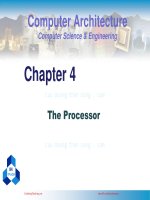kiến trúc máy tính võ tần phương final solution 071 sinhvienzone com
Bạn đang xem bản rút gọn của tài liệu. Xem và tải ngay bản đầy đủ của tài liệu tại đây (88.55 KB, 9 trang )
ICS 233 - Computer Architecture
& Assembly Language
Final Exam – Fall 2007
Wednesday, January 23, 2007
7:30 am – 10:00 am
Computer Engineering Department
College of Computer Sciences & Engineering
King Fahd University of Petroleum & Minerals
Student Name:
SOLUTION
Student ID:
Q1
/ 10
Q2
/ 20
Q3
/ 15
Q4
/ 15
Q5
/ 20
Q6
/ 25
Total
/ 105
Important Reminder on Academic Honesty
Using unauthorized information or notes on an exam, peeking at others work, or
altering graded exams to claim more credit are severe violations of academic
honesty. Detected cases will receive a failing grade in the course.
Page 1 of 9
Prepared by Dr. Muhamed Mudawar
CuuDuongThanCong.com
/>
Page 2 of 9
Q1. (10 pts) Consider the following MIPS code sequence:
lw
$5, 100($2)
add $2, $3, $5
sub $5, $5, $2
sw
a)
b)
$5, 100($2)
(5 pts) Identify all the RAW dependencies between pairs of instructions.
lw
$5, 100($2) and
add $2, $3, $5
lw
$5, 100($2) and
sub $5, $5, $2
add $2, $3, $5
and
sub $5, $5, $2
add $2, $3, $5
and
sw
$5, 100($2)
sub $5, $5, $2
and
sw
$5, 100($2)
(3 pts) Identify all the WAR dependencies between pairs of instructions
lw
$5, 100($2) and
add $2, $3, $5
c)
and
add $2, $3, $5
sub $5, $5, $2
(2 pts) Identify all the WAW dependencies between pairs of instructions
lw
$5, 100($2) and
CuuDuongThanCong.com
sub $5, $5, $2
/>
Page 3 of 9
Q2. (20 pts) We have a program core consisting of five conditional branches. The program
core will be executed millions of times. Below are the outcomes of each branch for one
execution of the program core (T for taken and N for not taken).
Branch 1: T-T-T-T-T
Branch 2: N-N-N
Branch 3: T-N-T-N-T-N-T-N
Branch 4: T-T-T-N-N-N
Branch 5: T-T-T-N-T-T-T-N-T
Assume that the behavior of each branch remains the same for each program core
execution. For dynamic branch prediction schemes, assume that each branch has its own
prediction buffer and each buffer is initialized to the same state before each execution.
List the predictions and the accuracies for each of the following branch prediction
schemes:
a)
b)
c)
d)
Always taken
Always not taken
1-bit predictor, initialized to predict taken
2-bit predictor, initialized to weakly predict taken
a)
Branch 1: prediction = T-T-T-T-T,
Branch 2: prediction = T-T-T,
Branch 3: prediction = T-T-T-T-T-T-T-T,
Branch 4: prediction = T-T-T-T-T-T,
Branch 5: prediction = T-T-T-T-T-T-T-T-T,
correct = 5, wrong = 0
correct = 0, wrong = 3
correct = 4, wrong = 4
correct = 3, wrong = 3
correct = 7, wrong = 2
Total correct = 19, Total wrong = 12, Accuracy = 19/31 = 61.3%
b)
Branch 1: prediction = N-N-N-N-N,
Branch 2: prediction = N-N-N,
Branch 3: prediction = N-N-N-N-N-N-N-N,
Branch 4: prediction = N-N-N-N-N-N,
Branch 5: prediction = N-N-N-N-N-N-N-N-N,
correct = 0, wrong = 5
correct = 3, wrong = 0
correct = 4, wrong = 4
correct = 3, wrong = 3
correct = 2, wrong = 7
Total correct = 12, Total wrong = 19, Accuracy = 12/31 = 38.7%
c)
Branch 1: prediction = T-T-T-T-T,
Branch 2: prediction = T-N-N,
Branch 3: prediction = T-T-N-T-N-T-N-T,
Branch 4: prediction = T-T-T-T-N-N,
Branch 5: prediction = T-T-T-T-N-T-T-T-N,
correct = 5, wrong = 0
correct = 2, wrong = 1
correct = 1, wrong = 7
correct = 5, wrong = 1
correct = 5, wrong = 4
Total correct = 18, Total wrong = 13, Accuracy = 18/31 = 58.1%
d)
Branch 1: prediction = T-T-T-T-T,
Branch 2: prediction = T-N-N,
Branch 3: prediction = T-T-T-T-T-T-T-T,
Branch 4: prediction = T-T-T-T-T-N,
Branch 5: prediction = T-T-T-T-T-T-T-T-T,
correct = 5, wrong = 0
correct = 2, wrong = 1
correct = 4, wrong = 4
correct = 4, wrong = 2
correct = 7, wrong = 2
Total correct = 22, Total wrong = 9, Accuracy = 22/31 = 71%
CuuDuongThanCong.com
/>
Page 4 of 9
Q3. (15 pts) Consider a direct-mapped cache with 128 blocks. The block size is 32 bytes.
a) (3 pts) Find the number of tag bits, index bits, and offset bits in a 32-bit address.
Offset bits = 5
Index bits = 7
Tag bits = 32 – 12 = 20 bits
b) (4 pts) Find the number of bits required to store all the valid and tag bits in the cache.
Total number of tag and valid bits = 128 * (20 + 1) = 2688 bits
c) (8 pts) Given the following sequence of address references in decimal:
20000, 20004, 20008, 20016, 24108, 24112, 24116, 24120
Starting with an empty cache, show the index and tag for each address and indicate
whether a hit or a miss.
Address = Hex
Offset (5 bits) Index (7 bits)
Tag
20000 = 0x4E20
0x00 = 0
0x71 = 113
4
Miss (initially empty)
20004 = 0x4E24
0x04 = 4
0x71 = 113
4
Hit
20008 = 0x4E28
0x08 = 8
0x71 = 113
4
Hit
20016 = 0x4E30
0x10 = 16
0x71 = 113
4
Hit
24108 = 0x5E2C
0x0C = 12
0x71 = 113
5
Miss (different tag)
24112 = 0x5E30
0x10 = 16
0x71 = 113
5
Hit
24116 = 0x5E34
0x14 = 20
0x71 = 113
5
Hit
24120 = 0x5E38
0x18 = 24
0x71 = 113
5
Hit
CuuDuongThanCong.com
Hit or Miss
/>
Page 5 of 9
Q4. (15 pts) A processor runs at 2 GHz and has a CPI of 1.2 without including the stall
cycles due to cache misses. Load and store instructions count 30% of all instructions.
The processor has an I-cache and a D-cache. The hit time is 1 clock cycle. The I-cache
has a 2% miss rate. The D-cache has a 5% miss rate on load and store instructions.
The miss penalty is 50 ns, which is the time to access and transfer a cache block between
main memory and the processor.
a)
(3 pts) What is the average memory access time for instruction access in clock cycles?
Miss penalty = 50 ns * 2 GHz = 100 clock cycles
AMAT = hit time + miss rate * miss penalty = 1 + 0.02 * 100 = 3 clock cycles
b)
(3 pts) What is the average memory access time for data access in clock cycles?
AMAT = 1 + 0.05 * 100 = 6 clock cycles
c)
(4 pts) What is the number of stall cycles per instruction and the overall CPI?
Stall cycles per instruction = 1 * 0.02 * 100 + 0.3 * 0.05 * 100 = 3.5 cycles
Overall CPI = 1.2 + 3.5 = 4.7 cycles per instruction
d)
(5 pts) You are considering replacing the 2 GHz CPU with one that runs at 4 GHz, but is
otherwise identical. How much faster does the new processor run? Assume that hit time
in the I-cache and the D-cache is 1 clock cycle in the new processor, and the time to
access and transfer a cache block between main memory and the processor is still 50 ns.
For the new processor running at 4 GHz:
Miss penalty = 50 ns * 4 GHz = 200 clock cycles
Stall cycles per instruction:
(1 * 0.02 + 0.3 * 0.05) * 200 = 7 cycles
Overall CPI = 1.2 + 7 = 8.2 cycles per instruction
Speedup = (CPIc / CPId) * (Clock Rated / Clock Ratec) = (4.7 / 8.2) * (4/2) = 1.146
CuuDuongThanCong.com
/>
Page 6 of 9
Q5. (20 pts) Consider the following idea: we want to modify all load and store instructions in the instruction set such that the offset is always 0. The load
and store instructions can be of the R-type and there is NO need for the ALU to compute the memory address. This means that all load and store
instructions will have the following format, where Rs is the register that contains the memory address.
LW
SW
# No immediate constant used
# No immediate constant used
(10 pts) Draw the modified single-cycle datapath. Identify the changes that you are making to the single-cycle datapath.
IF = Instruction
Fetch
ID = Decode and
Register Fetch
EX = Execute and
Memory Access
Inc
Imm16
00
0
1
Rs
PC
Address
zero
Registers
Rt
Instruction
Instruction
Memory
0
m
u
Rd x
1
BusW
m
u
x
A
d
d
Extend
Rw
a)
Rt, (Rs)
Rt, (Rs)
0
m
u
x
A
L
U
1
WB = Write
Back
0
m
ALU result u
x
1
Data
Memory
Address
Data in
CuuDuongThanCong.com
/>
Page 7 of 9
b)
(4 pts) Assume that the operation delays for the major components are as follows:
Instruction Memory: 200 ps
Data Memory: 200 ps
ALU: 150 ps
Register file (read or write): 100 ps
Ignore the delays in the multiplexers, control, PC access, extension logic, and wires.
What is the cycle time for the single-cycle datapath BEFORE and AFTER making the
modification?
BEFORE making the modification:
Cycle time = 200 + 100 + 150 + 200 + 100 = 750 ps
AFTER making the modification:
Cycle time = 200 + 100 + max(150, 200) + 100 = 200 + 100 + 200 + 100 = 600 ps
c)
(6 pts) Because we have removed the offset in all load and store instructions, all original
load-store instructions with non-zero offsets would now require an additional ADDI
instruction to compute the address. This will increase the instruction count.
Suppose we have a program in which 20% of the instructions are load-store instructions.
Assume further that only 10% of the original load-store instructions have a non-zero
offset and would require an additional ADDI instruction to compute the address.
What is the percent increase in the instruction count when additional ADDI instructions
are used?
Percent increase in the instruction count = 20% * 10% = 2% (for additional ADDI)
Which design is better, the original one that allowed non-zero offsets, or the modified
one with zero offsets, and why?
Execution Time = Instruction Count * CPI * Clock Cycle
CPI = 1 in both cases because this is single-cycle design
Original Design Execution Time = I-Count * 1 * 750 ps = 750 I-Count
Modified Design Execution Time = 1.02 I-Count * 1 * 600 ps = 612 I-Count
Modified Design is better because it takes less time to execute program
What is the speedup factor?
Speedup factor = 750 / (600*1.02) = 1.225
CuuDuongThanCong.com
/>
Page 8 of 9
Q6. (25 pts) Use the following MIPS code fragment:
I1:
I2:
Loop:
I3:
I4:
I5:
I6:
I7:
I8:
I9:
I10:
a)
ADDI
ADD
$3, $0, 100
$4, $0, $0
# $3 = 100
# $4 = 0
LW
ADD
LW
SUB
ADDI
ADDI
ADDI
BNE
$5,
$4,
$6,
$4,
$1,
$2,
$3,
$3,
# $5 =
# $4 =
# $6 =
# $4 =
# $1 =
# $2 =
# $3 =
if ($3
0($1)
$4, $5
0($2)
$4, $6
$1, 4
$2, 4
$3, -1
$0, Loop
MEM[$1]
$4 + $5
MEM[$2]
$4 – $6
$1 + 4
$2 + 4
$3 – 1
!= 0) goto Loop
(10 pts) Show the timing of one loop iteration on the 5-stage MIPS pipeline without forwarding hardware. Complete the timing table, showing
all the stall cycles. Assume that the branch will stall the pipeline for 1 clock cycle only.
I1: ADDI
I2: ADD
I3: LW
I4: ADD
I5: LW
1
2
3
4
5
6
IF
ID
EX
M
WB
IF
ID
EX
M
WB
IF
ID
EX
M
IF
stall stall
8
9
10
ID
EX
M
WB
2 stall cycles IF
ID
EX
M
IF
stall stall
I6: SUB
I7: ADDI
I8: ADDI
I9: ADDI
I10: BNE
7
11
12
13
14
15
16
ID
EX
M
WB
2 stall cycles IF
ID
EX
M
WB
IF
ID
EX
M
WB
IF
ID
EX
M
IF
stall stall
17
18
19
20
21
22
IF
ID
EX
M
WB
1 delay cycle
IF
stall stall
24
25
EX
M
WB
WB
WB
WB
ID
2 stall cycles IF
I3: LW
I4: ADD
ID
Time of one loop iteration = 15 cycles
CuuDuongThanCong.com
23
/>
Page 9 of 9
b)
(5 pts) According to the timing diagram of part (a), compute the number of clock cycles
and the average CPI to execute ALL the iterations of the above loop.
There are 100 iterations
Each iteration requires 15 cycles =
8 cycles to start the 8 instructions in loop body + 7 stall cycles
There are 2 additional cycles to start the first 2 instructions before the loop.
Therefore, total cycles = 100 * 15 + 2 (can be ignored) = 1502 cycles ≈ 1500 cycles
Total instruction executed = 2 + 8 * 100 = 802 instructions (counting first two)
Average CPI = 1502 / 802 = 1.87
If we ignore first two instructions and the time to terminate last iteration then
Average CPI = 1500/800 = 1.88 (almost same answer)
c)
(5 pts) Reorder the instructions of the above loop to fill the load-delay and the branchdelay slots, without changing the computation. Write the code of the modified loop.
ADDI
ADD
Loop:
LW
LW
ADDI
ADD
ADDI
ADDI
BNE
SUB
$3, $0, 100
$4, $0, $0
# $3 = 100
# $4 = 0
$5,
$6,
$3,
$4,
$1,
$2,
$3,
$4,
#
#
#
#
#
#
#
#
0($1)
0($2)
$3, -1
$4, $5
$1, 4
$2, 4
$0, Loop
$4, $6
$5 = MEM[$1]
Moved earlier to avoid load-delay
Moved earlier
$4 = $4 + $5
$1 = $1 + 4
$2 = $2 + 4
if ($3 != 0) goto Loop
Fills branch delay slot
Other re-orderings are possible as long as we avoid the load
delay and we fill branch delay slot with an independent
instruction. We should be able to reduce the stall cycles to 0.
d)
(5 pts) Compute the number of cycles and the average CPI to execute ALL the iteration
of the modified loop. What is the speedup factor?
There are 100 iterations
Each iteration requires 8 cycles =
8 cycles to start the 8 instructions in loop body + 0 stall cycles
There are 2 additional cycles to start the first 2 instructions before the loop
+ 4 additional cycles to terminate the ADDI instruction in the last iteration.
Therefore, total cycles = 100 * 8 + 6 (can be ignored) = 806 cycles ≈ 800 cycles
Total instruction executed = 2 + 8 * 100 = 802 instructions (counting first two)
Average CPI = 806 / 802 = 1.00
If we ignore first two instructions and the time to terminate last iteration then
Average CPI = 800/800 = 1.00 (almost same answer)
Speedup Factor = CPIpart-b/CPIpart-d = 1.88/1.00 = 1.88
CuuDuongThanCong.com
/>









